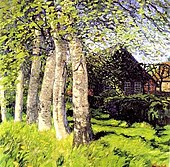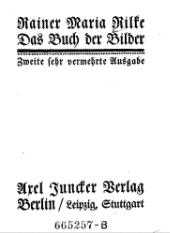The book of pictures
The book of pictures is the title of a collection of poems by Rainer Maria Rilke . The first edition appeared in 1902 and comprised 45 poems. It was followed in 1906 by a second edition that was expanded to include 37 poems and significantly changed in terms of form and content .
While the first version was no longer printed, the second saw many new editions. Ultimately, the fifth edition, taken over by Insel Verlag in 1913, was authoritative in terms of editing .
The collection dedicated to Gerhart Hauptmann “in love and out of gratitude for Michael Kramer ” is considered an important work of Impressionism and forms a transition between Rilke's emotional and moody early phase and his New Poems .
Emergence
The first edition, limited to just 500 copies, was published by Axel Junker Verlag and was also a visually thoroughly composed work. It was printed entirely in capital letters, not paginated, and had a pen drawing by Heinrich Vogeler as its title vignette : a fountain in a stylized park. Rilke explained this to his publisher Axel Juncker by emphasizing the connection between content and external form. The characteristic of the verses becomes clear through the "standing, monumental even the smallest words ...". There is “nothing unimportant, nothing unwholesome”.
Most of the 45 poems in the first collection that Rilke wrote between 1897 and 1901 were written in Berlin-Schmargendorf and Worpswede .
During his time in Berlin, Rilke also wrote the White Princess , the Cornet and the Book of Hours , which included experiences during the two trips to Russia with Lou Andreas-Salomé . He processed his first trip in 1899 in a few poems that can be found in the Book of Pictures . Above all, the verses in which he takes up sacred motifs connect the volume with the religious cycle.
In the autumn of 1900 he spent a few months in the Worpswede artists' colony , where he met the sculptor Clara Westhoff , whom he married on April 28, 1901. He also got to know her friend Paula Modersohn-Becker and dedicated a short stanza to her in the book of poems . Many of his experiences there, which he confided in detail in his diaries, were included in the poem drafts for the first edition.
In May and June 1906, Rilke added 37 poems to the cycle, changed the order of the individual works and simplified the printed image. He dispensed with the vignette and the continuous capital letters and now had the text set in Fraktur and no longer capitals. He wrote to his publisher Axel Juncker at Christmas 1906 that a new and “very characteristic unit had been created, a really new book”.
particularities
Most of the older texts can be found in the first part of the first book and encircle characters such as girls and children , angels and saints . For the second edition, Rilke moved the poems with religious motifs to the first part of the second book.
The works of the first edition are still strongly reminiscent of those in the volume Mir zur Celebration published in 1899 . Formally, this can be seen in Rilke's typical and virtuoso use of onomatopoeic means such as alliterations and assonances as well as the emotional emphasis of the lyrical ego , in terms of content, however, through motifs such as "knight", "moon night" and "girl melancholy", which he took up again in the neo-romantic style .
Comparable to the second version of the White Princess , Rilke tried with the new edition to build a bridge between the early and middle works by building on his previous work, expanding and modifying it and thus adapting it to his changed poetics.
When he started to add to the collection, he realized that not all of the verses that had been written in the meantime could be integrated into the volume of poetry. So he wrote to his wife Clara on February 1, 1906, that the poems selected for the new book of pictures were "which cannot yet be counted among the closest, equal to the panther ".
In this way, the second version of the book was given a further meaning: since it overlapped with the creation of the New Poems , he was able to collect the verses in it that no longer corresponded to the aesthetics of the new dinglyric.
Poems included
literature
- Jutta Heinz: The book of pictures. (1st version, 1902) in: Rilke manual, Life - Work - Effect. Ed .: Manfred Engel with the collaboration of Dorothea Lauterbach, Metzler, Stuttgart 2013, ISBN 978-3-476-02526-5 , pp. 227-233.
- Jutta Heinz: The book of pictures. (2nd version, 1906) in: Rilke Handbook, Life - Work - Effect , Ed .: Manfred Engel with the collaboration of Dorothea Lauterbach, Metzler, Stuttgart 2013, pp. 290–296
- Joachim W. Storck, Rainer Maria Rilke: The book of pictures. in: Kindlers Neues Literatur-Lexikon, Vol. 14, Munich, 1991, Kindler Verlag, Munich 1991, ISBN 3-463-43014-2 , pp. 140-142
Web links
Individual evidence
- ↑ Jutta Heinz, in: Rilke manual, Life - Work - Effect, Metzler, Ed. Manfred Engel, Stuttgart 2013, p. 227
- ↑ Quoted from: Jutta Heinz, in: Rilke-Handbuch, Leben - Werk --ffekt, Metzler, Ed. Manfred Engel, Stuttgart 2013, p. 228
- ↑ Jutta Heinz, in: Rilke manual, Life - Work - Effect, Metzler, Ed. Manfred Engel, Stuttgart 2013, p. 227
- ↑ Quoted from: Jutta Heinz, in: Rilke-Handbuch, Leben - Werk --ffekt, Metzler, Ed. Manfred Engel, Stuttgart 2013, p. 227
- ↑ Joachim W. Storck, Rainer Maria Rilke: The book of pictures. in: Kindlers Neues Literatur-Lexikon, Vol. 14, Munich, 1991, p. 141
- ↑ Quoted from: Jutta Heinz, in: Rilke-Handbuch, Leben - Werk --ffekt, Metzler, Ed. Manfred Engel, Stuttgart 2013, p. 290


